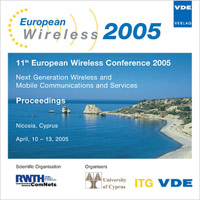A Table-driven AOA Estimation Algorithm for Switched-beam Antennas in Wireless Networks
Konferenz: European Wireless 2005 - 11th European Wireless Conference 2005 - Next Generation wireless and Mobile Communications and Services
10.04.2006 - 13.04.2005 in Nicosia, Cyprus
Tagungsband: European Wireless 2005
Seiten: 6Sprache: EnglischTyp: PDF
Persönliche VDE-Mitglieder erhalten auf diesen Artikel 10% Rabatt
Autoren:
Lee, Jeongkeun; Kwon, Taekyoung; Choi, Yanghee (School of Computer Science and Engineering, Seoul National University, Korea)
Kim, Dongkyun (Department of Computer Engineering, Kyungpook National University, Korea)
Toh, C. K. (Communication Networks, University of London, UK)
Inhalt:
Accurate Angle of Arrival (AOA) estimation is crucial in two aspects: adaptive beam-forming in smart antenna systems and object positioning in ubiquitous computing applications. The AOA information is essential for smart antenna systems in order to improve efficiency (e.g. throughput enhancement) in transmission and reception. The AOA information assists the system to automatically change the direction of the radiation/reception beam pattern to adapt to the position of the receiver/sender, respectively. This adaptive beam forming technique can maximize the signal-to-interference/noise-ratio (SINR). In ubiquitous computing applications, AOA information is utilized for the purpose of positioning of the object with a wireless interface. However, the existing AOA estimation algorithms incur large computational complexity or exhibit antenna design-dependent performance. In this paper, we propose a simple table-driven AOA estimation (TAE) algorithm for a switched-beam antenna system. Due to its relatively low hardware complexity and cost, the switched beam antenna system is most widely implemented type in smart antenna systems. Simulation results show that the proposed table-driven approach yields a low estimation error (half of angular granularity) with O(1) computational complexity. We also demonstrated that the performance of our TAE algorithm is independent of beam-coverage, beam-width and side-lobe level.


